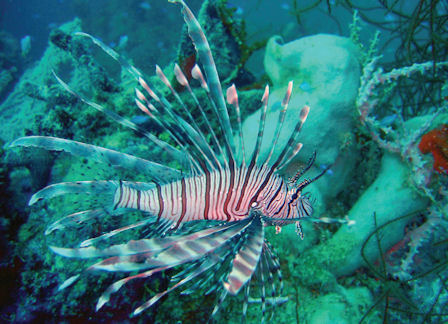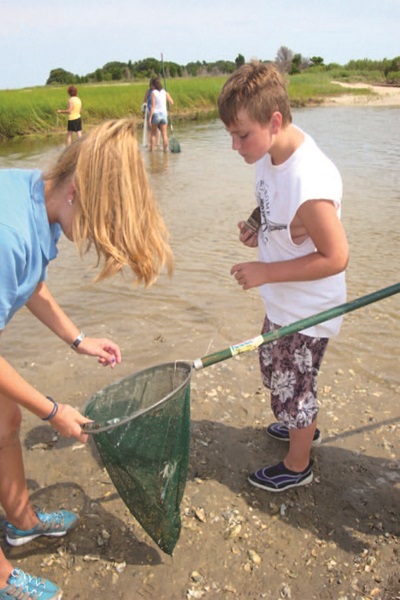LOCAL CATCH: Hunting Lions

In early June, the “If You Can’t Beat ‘Em, Eat ‘Em” lionfish/lobster spearfishing tournament took place in Carteret County.
The nine-day event was developed to reduce the number of lionfish on artificial reefs off the North Carolina coast and promote eating the fish — an invasive species and competitor to many valuable North Carolina fisheries species.
“A big part of this is public awareness — that there is an invasive species problem — but also to make the public aware that they are edible,” says Janelle Fleming, spokesperson for the tournament. She is a SCUBA instructor at Discovery Diving and a researcher at University of North Carolina’s Institute of Marine Sciences.

In 2013, Libby Eaton, the owner-operator of Bistro by the Sea restaurant in Morehead City, took a trip to Belize. A seafood restaurant owner who prides herself on serving local and nontraditional species, Eaton was interested in trying lionfish on her trip. But, she says, the fish that has dramatically expanded its range in tropical waters of the United States and the Caribbean was not on the menu.
“They said the fish were all gone,” Eaton says. She was told that while the fish had been a problem a few years ago, tournaments and fishing pressure had drastically reduced their numbers.
“That got me thinking,” Eaton says. “Why can’t we do that here?”
Eaton contacted Discovery Diving in Beaufort to see if holding a tournament might be possible. Discovery Diving had been running lionfish derbies — competitions for fun rather than money — since the early 2000s. They also sell lionfish to fish buyers from time to time.
“The big issue that is different for us here in North Carolina versus in Belize or in the Keys is our depth ranges,” Fleming says. “We are the Graveyard of the Atlantic but you have to go so far offshore — 25 or 30 miles offshore — in deep waters — 100 feet or so — to catch these lionfish. Whereas in the Keys, you can go as far offshore as 500 meters and you will be able to find lionfish in 30 feet of water.”
Despite the differences, Fleming and Discovery Diving owner Debby Boyce thought the tournament was a good idea and agreed to help. The event also was sponsored in part by the Eastern Carolina Artificial Reef Association, a local nonprofit that seeks to promote artificial reef building, and Carteret Catch, another local nonprofit that seeks to promote local fisheries.
“It just seemed like right now was the perfect time because we had more interest from restaurants and other areas,” Fleming says.
Another person who liked the plan was James Morris, an ecologist with the National Oceanic and Atmospheric Administration. Morris, who specializes in lionfish, says that tournaments of this type can help keep local lionfish populations in check in specific areas like on reefs and in marine protected areas.
“We know that eradicating lionfish from the Atlantic Ocean is likely impossible,” Morris says. “But we’re seeing that local control programs are being successful throughout the region.”
Charlie Coffman did his bit to help reduce lionfish numbers. Winner of the lionfish portion of the tournament, Coffman caught 50 of the 250 total fish removed during the competition. Coffman speared the fish in two dives near the wreck of the Naeco in 110 to 140 feet of water about 40 miles offshore. For his efforts, he received a $500 cash prize.
“Anytime there is a lionfish roundup, I try to go out and get as many as I can,” Coffman says. “They were covering that whole wreck.”
Besides reducing lionfish numbers and raising awareness, the tournament also benefits lionfish research. Morris was able to obtain the stomach contents of all of the lionfish caught during the tournament.
While Morris has yet to analyze the contents of all of the stomachs, he did see a trend while he was removing them.

“We definitely observed lionfish predation on vermillion snapper and many smaller sport fishes on the wreck,” he says.
Lionfish compete with fishery species like vermillion snapper for food in addition to eating them directly. Luckily, lionfish themselves taste good.
“Here’s a fish in tremendous supply,” says Barry Nash, North Carolina Sea Grant seafood technology and marketing specialist. “If we can demonstrate to people that they are safe and good to eat, maybe we can create a market for them.”
In Florida, some researchers have expressed concern that the fish could contain ciguatoxins — naturally occurring toxins made by algae in warm, tropical or subtropical waters such as the Caribbean. Ciguatera is a type of food poisoning caused by eating fish that has a buildup of the toxins.
“Ciguatera is likely not to be an issue for North Carolina lionfish,” Morris says. “We have traditionally not had any problems with ciguatoxins in reef fish off of North Carolina.”
After Morris measured and removed the stomachs, Eaton collected the catch for preparation at the Big Rock Blue Marlin Tournament weigh-in the following week.
“We char grilled and served them with Japanese bread crumbs,” Eaton says. “People loved it.”
For more information about the event, visit www.carolinareef.org and search for “lionfish.”
EATING THE INVADER
On a recent afternoon in the North Carolina State University Center for Marine Sciences and Technology test kitchen, North Carolina Sea Grant seafood specialist Barry Nash and Mariner’s Menu blogger Vanda Lewis cooked lionfish with fresh herbs (see recipe in the Coastwatch article, Ingesting Invaders: Serving Up Lionfish) while working on a brochure explaining how to prepare and serve them.
The thick white fillets had a little give to them and were flaky — a texture somewhere between that of triggerfish and flounder.
A reason lionfish are not more common on North Carolina plates is their formidable spines, which are venomous.
“Yes, they have poisonous spines but the meat is good to eat,” says Nash, who suggests clipping the spines off with kitchen shears before filleting the fish. He explains this process in the Coastwatch article, How to Dress and Fillet Lionfish.
This article was published in the Autumn 2013 issue of Coastwatch.
For contact information and reprint requests, visit ncseagrant.ncsu.edu/coastwatch/contact/.
- Categories:


